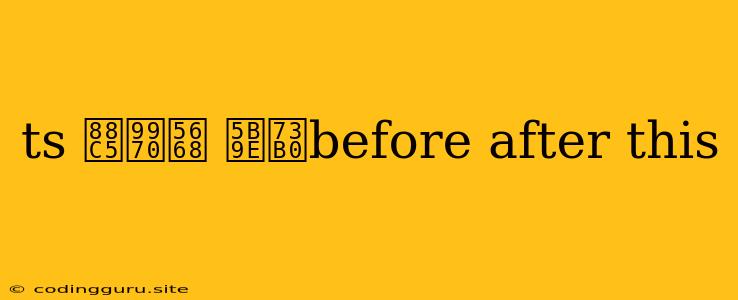Understanding TypeScript Decorators: Implementing "Before," "After," and "This"
TypeScript decorators, introduced in version 2.7, provide a powerful and elegant way to extend the functionality of classes, methods, and properties. They allow you to add metadata and modify behavior without directly changing the original code. In this article, we'll explore how decorators can be used to implement common patterns like "before," "after," and "this" within your TypeScript applications.
What are Decorators?
In essence, decorators are functions that take a target (like a class, method, or property) and apply modifications to it. They're defined using the @ symbol followed by the decorator function name.
function MyDecorator(target: any, propertyKey: string, descriptor: PropertyDescriptor) {
// Decorator logic here
}
class MyClass {
@MyDecorator
myMethod() {
// Method implementation
}
}
In the example above, MyDecorator is a decorator function that's applied to the myMethod within the MyClass.
Implementing "Before" and "After" Logic with Decorators
A frequent use case for decorators is to execute code before or after a method is called. Let's see how we can achieve this:
function Before(target: any, propertyKey: string, descriptor: PropertyDescriptor) {
const originalMethod = descriptor.value;
descriptor.value = function(...args: any[]) {
console.log(`Before: ${propertyKey}`);
const result = originalMethod.apply(this, args);
console.log(`After: ${propertyKey}`);
return result;
};
}
class MyClass {
@Before
myMethod(message: string) {
console.log(message);
}
}
const instance = new MyClass();
instance.myMethod('Hello from myMethod!');
In this example, the Before decorator intercepts the myMethod call. It stores the original method implementation (originalMethod) and replaces it with a new function. This new function logs a message "Before" the method is executed, calls the original method, logs another message "After" the execution, and finally returns the result.
Accessing "This" Inside Decorators
The this keyword inside a decorator refers to the target object (the class instance where the decorated element resides). Let's demonstrate how to access and use this within a decorator:
function LogThis(target: any, propertyKey: string, descriptor: PropertyDescriptor) {
const originalMethod = descriptor.value;
descriptor.value = function(...args: any[]) {
console.log(`This inside decorator: ${this.name}`);
const result = originalMethod.apply(this, args);
return result;
};
}
class MyClass {
name: string = 'MyClass Instance';
@LogThis
myMethod() {
console.log('Inside myMethod');
}
}
const instance = new MyClass();
instance.myMethod();
Here, the LogThis decorator logs the name property of the MyClass instance, demonstrating the ability to access the this context.
Advanced Decorator Patterns
Decorators can be used for various other purposes, such as:
- Method Validation: Enforce data types or constraints before executing a method.
- Caching: Store and reuse results of expensive operations.
- Dependency Injection: Inject external services or dependencies into classes.
- Logging: Track method calls and their parameters.
Conclusion
TypeScript decorators offer a powerful way to add modularity, extensibility, and behavior modification to your code without directly altering the original source. By understanding the core principles and applying them to specific scenarios like "before," "after," and "this," you can write cleaner, more maintainable, and more expressive TypeScript code. Remember to explore various decorator patterns to unlock their full potential for enhancing your TypeScript projects.
